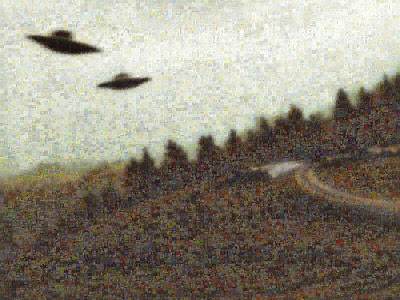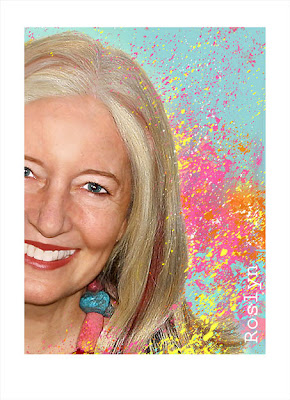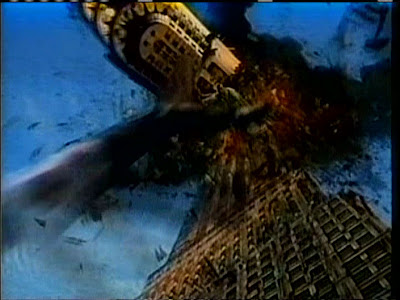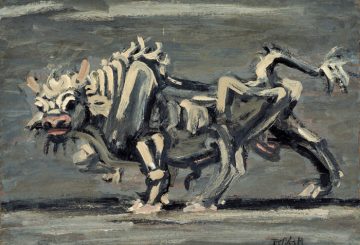Who ever said ideas had to be subtle? If you want cut through, why even bother with artistic ambiguity? Just say what you have to say and off you go. This seems to be Joan Fontecuberta’s concept for his show Googlegrams at the Australian Centre for Photography. Taking his cue from those image collage programs where lots of tiny pictures make up one really big picture, Googlegrams uses a bit of software that trawls through images found on the web for the building blocks of the bigger pictures. For example, Fontecuberta uses tiny images of politicians who decided to invade Iraq to make up a really big picture of a body with its head blown apart or an image of UFOs made up of tiny images the people who claimed to have seen them.

If this idea reminds you of anything it should be those photo mosaic pictures using exactly the same idea that you can buy in poster shops and tourist souvenir stores. Fontecuberta hasn’t really done anything different to the commercial application of the work and can be at least credited with a brutal sort of simplicity that takes all the subtlety out of a process. Unfortunately it’s not really a process that has much room for irony. In the gallery there’s a computer set up which visitors can test out their own ideas with a series of basic templates – the Australian flag, John Howard’s face, an outback landscape. If you decided to use Fontecuberta’s program to create an Australian flag out of – say – Indigenous art – you might be saying something about Australia and it’s relationship to its Indigenous people. If on the other hand you enter “Teletubbies” + “Thomas The Tank Engine” + “Anal Porn” [as we did] you get an Australian flag made up of La La, Po, Tinky Winky, Dipsy, Thomas and Friends, and hot back door action. What does it mean? Probably nothing.
The room sheet claims that the tension in the image is not between the scale of the images, or that the small images have some sort of conceptual interplay with the large image, but that the real interest here is the interplay between different flows of information from the “fundamentally uncritical space of the internet” from which the images are derived. It’s an interesting proposition to consider that the image is invested with criticality when we would have thought the criticality is the context, and more importantly, in the way in the image is interpreted, that is, by the audience, without whom Fontecuberta’s work would be meaningless. This is the connection between Googlegrams and d/Lux/MediaArts d/art/07. You can tell by all the capitalization and forward slashes that d/Art/07 is a new media exhibition and, if you a hankering for a video wall, an online virtual Pony Club, and some almost random seeming video works, it doesn’t disappoint. If on the other hand you expect your ‘post cinema’ experience a little more substantial than a room of monitors and some wall texts that escaped proof reading, avoid.

Tracey Moffatt, Roslyn Oxley is my dealer in Sydney, 2007.
Archival ink on rag paper, 74x53cms. Edition of 5 + 2AP.
Courtesy Roslyn Oxley Gallery.
There’s nothing much good to be said about Tracey Moffatt’s show Portraits & Doomed at Roslyn Oxley Gallery [until Saturday], a suite of almost identical portraits of friends, family, fellow artists and people she met at parties. Moffatt continues her fascination with celebrity, the logical connection between this slim body of work and her previous shows Under The Sign of Scorpio and Fourth. It may be that some of these people are well known – Eubena Nampitjin, Roslyn Oxley, Marina Abramovic – or others are unknown – her brother Lloyd for example – but Moffatt treats them all as if they were destined for the pages of New Weekly. She’s given the titles of the work jokey by-line style bios such as Anne Slater is a New York Socialite or Francisco Costa is a designer for Calvin Klein Fashions in New York and Eubena Nampatjin is a painter who lives in the desert. The idea is there for all to see, the images are garish and so another year and another show by Tracey Moffatt.

Tracey Moffatt and Gary Hillberg, Doomed, 2007.
10 mins dur. continuous loop, edition of 499.
Courtesy of Roslyn Oxley Gallery.
Moffatt has a new DVD for her show made with her long time video art collaborator Gary Hillberg. Following on from similar compilation videos Doomed is a series of frenetically edited clips from disaster movies set to a never ending build up on the score. Doomed shows that anyone with access to a video archive and iMovie can make a video art – the problem is that it’s not very good. One need only take a cursory look at what younger video artists are doing with this set of tools to see that Moffatt’s working is lacking – as a video it has no logical construction, it blasts along with its bits and pieces assembled ad hoc style, no build up or let down. Sure, the world ends, but the world ends every day. Meanwhile we have to admit to being mightily impressed with artist’s chutzpah. The DVDs – in an edition of 499 and selling fast – are available for USD$800 each. There has to be a law suit in there somewhere.

Michael Landy, H.2.N.Y. Self-Constructing, Self-Destroying Sculpture, 2007.
Oil stick on paper, 152 x 244 cm.
Copyright the artist.
Courtesy Sherman Galleries, Sydney and Thomas Dane Gallery, London.
Michael Landy is the UK artist famous for destroying everything he owned as part of an art work called Breakdown. Staged in a disused shop on Oxford Street in London in 2001, the set up was like a factory, with a moving production line of yellow plastic boxes in which each of Landy’s possessions were placed – his passport, personal papers, clothing, books, art works – weighed, recorded and the destroyed, literally everything the guy owned. Not even his childhood bear survived [Teddy, nooooo!!!]. Since then Landy has no doubt been building up his possessions again, or at least his passport, as he has a show called Man In Oxford Street Is Auto-Destructive at Sherman Galleries and he’s been out here for the opening and an artist talk.
Man In Oxford Street Is Auto-Destructive is an exhibition of large oil stick drawings in which Landy pays homage to Jean Tinguely’s Homage to New York, 1960, a sculpture that was supposed to auto-destruct in a performance in the sculpture court of the Museum of Modern Art, but instead shook a bit, then caught on fire, then was put out. Auto-not-destructing if you will. The connection between the title of Landy’s show at Sherman refers to both his own now infamous Breakdown and yr standard art historical antecedents.
The show at Sherman is set up as a kind of mirror image of Landy and Tinguely. Up the front of the gallery is a looped screening of a documentary of the 1960 event made by legendary documentary maker D.A. Pennebaker and a shorter version made by Robert Beer, then there are the big drawings of the Tinguely machine in reverse white on black in the main space, and then down the back of the gallery a looped screening of a documentary of Breakdown. The symmetry of the show is close to perfection. The problem we found with this otherwise excellent show is that it doesn’t leave much room for the imagination, impressive and as tight as the whole concept is. We like a bit of wiggle room for the audience to move about in, but Landy’s whole project – despite its low key razzamatazz – is far and away the best thing going on right now, so hell, we’ll take it without reservations.

